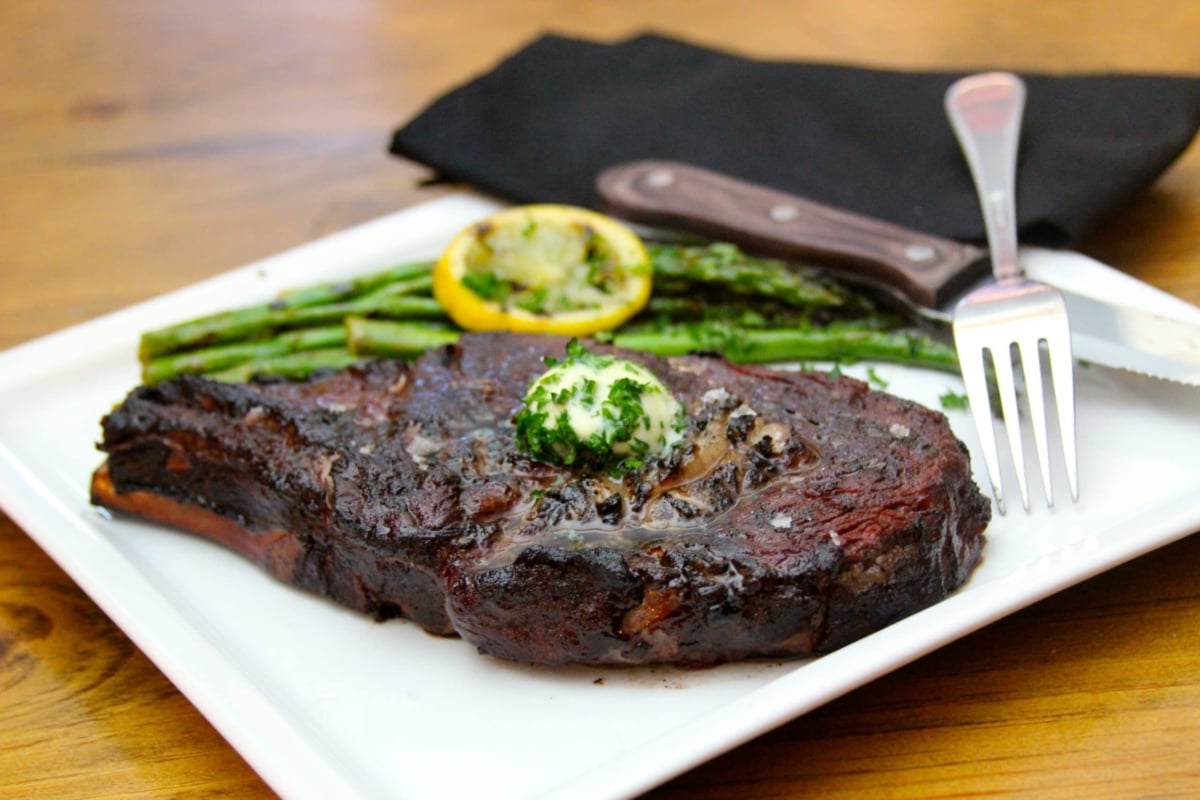Our sous-vide-que and reverse searing cooking methods ensure juicy, tender, and smoky steaks every time.
I am what some people might consider a ribeyeholic. Faced with the choice of any steak, or any cut of beef for that matter, I am always going to go back to a perfectly marbled, 1 1/2 to 2 inch/38.1 to 50.8 mm thick ribeye.
So I decided to apply the results of my experiment of different steak preparation methods where I discovered the power of The Big Chill and apply them to a ribeye. If you haven’t read that article, it will help you understand why I am recommending this technique.
The result? By following the controlled water bath (131°F/55°C for 2 hours based on our guide here for a 2-inch/50.8 mm thick tender cut of meat), rapid chill, smoke, and reverse sear method, I was able to create what, according to my wife, was the best ribeye I have ever made at home.
So why such a complicated cooking process? The short answer is, you’ve spent good time and money selecting the perfect steaks so why would you want to muck them up in a rush to make dinner? With a little planning, you can take advantage of the texture and tenderness benefits produced by sous vide while also striking the perfect balance of smoke and color via the reverse sear grilling method. In addition, the rapid chill between those two steps not only make a true reverse sear possible, it also allows you to prep the steaks well in advance then grill and serve when you are ready. Once cooked, finish the steaks with a compound butter or nice olive oil and enjoy the fruits of your labors!
Explore the world of Sous Vide Que, the ultimate marriage of water and smoke, by clicking here to download our ebook “Sous Vide Que Made Easy” for $3.99 on Amazon (free Kindle app runs on all computers). Or get the book and others FREE as a member of the AmazingRibs.com Pitmaster Club. Click here to join.
Also be sure to check out this video for Meathead’s sous vide “afterburner” (a technique you can learn more about here) steak. The video is a free preview of BBQ Stars (https://www.bbqstars.com), a premier collection of 120+ recipe and technique tutorials from some of the biggest names in barbecue and grilling available exclusively to AmazingRibs.com’s Pitmaster Club members (get for 30-day free trial here). You can also learn more about AmazingRibs.com’s BBQ Stars at https://amazingribs.com/bbq-stars/.
Makes:
Takes:
Ingredients
- 2 ribeyes, USDA Choice or better (approximately 2 pounds (.9 kilograms each))
- 2 teaspoons Morton Coarse Kosher Salt (1/2 teaspoon per pound (453.6 grams of meat))
- coarse ground black pepper
- 2 tablespoons unsalted butter at room temperature
- 2 tablespoons fresh parsley
- 1 garlic clove
These recipes were created in US Customary measurements and the conversion to metric is being done by calculations. They should be accurate, but it is possible there could be an error. If you find one, please let us know in the comments at the bottom of the page
Method
- Prep. At least an hour before starting the sous vide process, season the steak with kosher salt and place it in the fridge. This technique is called a dry brine and it does a great job of amplifying flavor because the salt is sucked down deep into the meat. Click here to read more about how dry brines work.
- Mince the garlic and finely chop the parsley. Set aside until ready to use.
- Sous vide. Prepare a sous vide immersion circulator such as Joule by ChefSteps according to instructions and set water temperature for 131°F (55°C).
- Place each steak in a separate vacuum seal bag or zipper freezer bag. If using freezer bags, carefully submerge them in the water bath until most of the air has been removed and then seal. Once bags are submerged, cook for two hours.
- Prior to the end of the sous vide process, fill a large container with a 50/50 mix of ice and water. Once steaks are finished, still in the bags, place them in the ice water for 30 to 60 minutes to quickly reduce the meat’s core temperature. Place steaks in the refrigerator until ready to grill (up to two days ahead of time).
- Fire up. Prepare a grill for 2-zone cooking. On a charcoal grill, place a chimney full of pre-heated charcoal briquets to one side of the grill's charcoal grate in order to create direct and an indirect cooking zones. You want one side scorching hot and the other side at about 225°F (107.2°C). Add 2 to 3 chunks of your favorite smoking wood to the charcoal for flavor. On a gas grill, adjust the temperature knobs so that one half of the grill is as hot as possible and the other half is approximately 225°F (107.2°C).
- Cook. Once the grill is ready, remove chilled steaks from the bags, pat dry, and season with cracked black pepper. Place on the cooler side of the grill as far away from the heat source as possible. Position the lid on the grill with the fully opened top vent positioned directly above the steak in order to force the smoke over and around the meat. Allow the steaks to smoke until they reached an internal temperature of 115°F (46.1°C) (note: a remote thermometer such as the Thermoworks Smoke allows you to set and monitor the internal temperature while attending to other matters such as side dishes).
- As the steaks cook, combine room temperature butter, parsley, and garlic and blend well. Set compound butter aside until ready to use.
- Once the steaks reach 115°F (46.1°C), open the lid and quickly sear the steaks while frequently flipping until an even crust has formed. At this point, the internal temperature of the steaks should be in the medium rare range, 130 to 135°F (54.4 to 57.2°C). It is best to aim for the lower temperature in order to avoid possible overcooking during carryover.
- Serve. Remove the steaks from the grill, plate, and top with compound butter (and optional large grain salt) before serving immediately.




High quality websites are expensive to run. If you help us, we’ll pay you back bigtime with an ad-free experience and a lot of freebies!
Millions come to AmazingRibs.com every month for high quality tested recipes, tips on technique, science, mythbusting, product reviews, and inspiration. But it is expensive to run a website with more than 2,000 pages and we don’t have a big corporate partner to subsidize us.
Our most important source of sustenance is people who join our Pitmaster Club. But please don’t think of it as a donation. Members get MANY great benefits. We block all third-party ads, we give members free ebooks, magazines, interviews, webinars, more recipes, a monthly sweepstakes with prizes worth up to $2,000, discounts on products, and best of all a community of like-minded cooks free of flame wars. Click below to see all the benefits, take a free 30 day trial, and help keep this site alive.
Post comments and questions below
1) Please try the search box at the top of every page before you ask for help.
2) Try to post your question to the appropriate page.
3) Tell us everything we need to know to help such as the type of cooker and thermometer. Dial thermometers are often off by as much as 50°F so if you are not using a good digital thermometer we probably can’t help you with time and temp questions. Please read this article about thermometers.
4) If you are a member of the Pitmaster Club, your comments login is probably different.
5) Posts with links in them may not appear immediately.
Moderators